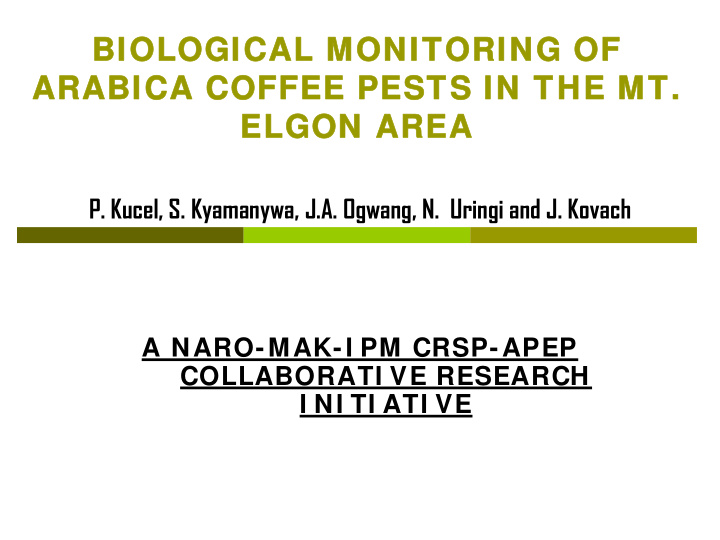



BIOLOGICAL MONITORING OF BIOLOGICAL MONITORING OF ARABICA COFFEE PESTS IN THE MT. ARABICA COFFEE PESTS IN THE MT. ELGON AREA ELGON AREA P. Kucel, S. Kyamanywa, J.A. Ogwang, N. Uringi and J. Kovach A NARO-MAK-I PM CRSP-APEP COLLABORATI VE RESEARCH I NI TI ATI VE
Main objective: DEVELOP AN IPM RESEARCH PROGRAM FOR MAJOR INSECT PESTS AND DISEASES OF ARABICA COFFEE IN THE MT. ELGON REGION. Component 1: Biological and production baseline surveys of arabica coffee in the Mt. Elgon area Component 2: Biological monitoring of arabica coffee pests in the Mt. Elgon area
Component 1: Biological and production baseline surveys of arabica coffee in the Mt. Elgon area Aimed to capture farmers’ perspective of: � the main constraints to arabica coffee production; � damage due to pests and diseases; � and the related pest management issues
Achievements: � Planning workshop for socio-economic surveys held during April 26 – 27, 2006 � Survey instrument, sampling strategy and survey methodology developed � Pre-testing of survey tools conducted in Sironko district; � Socio-economic baseline surveys completed during June, 2006 � Data management in progress
Component 2: Biological monitoring of arabica coffee pests in the Mt. Elgon area Specific objectives:- Compile an inventory of IPM research on coffee in Uganda. � Establish status and impact of Arabica coffee pests in the Mt. � Elgon area. Identify IPM research priorities for Arabica coffee in Uganda. � Use the information derived above to complete an IPM research � work plan for Arabica coffee.
Biological monitoring methodology � Planning workshop held during 8th – 10th June, 2006. � Draft work-plan reviewed and amended � Appropriate sampling tools developed � Recorders trained and data sheets pre-tested � Study sites selected by slope, and by altitude � Activities launced during 29 June – 2nd July, 2006. .
Sampling sites: 6 study locations Manafa, Mbale and Sironko districts; � Selected districts represent the Southern, Eastern and Western slopes; � Each district has 2 study sites in each of low to medium (up-to 1400masl) and high altitude areas (above 1400masl).
Sampling strategy � Data records taken monthly through the cropping season; � Each study site divided into 4 quadrants; � 4 coffee plants randomly sampled along the diagonal of each quadrant; � Data collected simultaneously at all sites during 2nd week of every month. � Sampling procedure for each pest type determined by its biology and ecology
Preliminary results Characteristics of pest incidences at low and high altitudes over time Antestia (L) 60 50 Stem borer (L) Incidence (%) 40 Root mealybugs (L) 30 Antestia (H) 20 Stem borer (H) 10 Root 0 mealybugs(H) July, 06 August, 06 September, October, 06 November, 06 December,06 January, 07 06 Sampling period
Characteristics of pest incidences at low and high altitudes over time Leaf miners(L) 18 Skeletonizers(L) 16 14 Lace bugs(L) In c id e n c e s (% ) 12 Cateppillar(L) 10 Leaf miners(H) 8 Skeletonizers(H 6 ) 4 Lace bugs(H) 2 Cateppillar(H) 0 July, 06 August, 06 September, 06 October, 06 November, 06 December,06 January, 07 Sampling period
Characteristics of pest incidences at low and high altitudes over time Coffee Berry 45 Borer(L) 40 Scales(L) 35 In c id e n c e s (% ) 30 Mealybugs(L) 25 20 Coffee Berry Borer(H) 15 10 Scales(H) 5 Mealybugs(H) 0 July, 06 August, 06 September, October, 06 November, 06 December,06 January, 07 06 Sampling period
Characteristic of disease incidences at low and high altitudes over time 50 45 Coffee leaf 40 rust(L) 35 In c id e n c e s (% ) CBD(L) 30 25 Coffee leaf rust(H) 20 15 CBD(H) 10 5 0 July, 06 August, 06 September, October, 06 November, 06 December,06 January, 07 06 Sampling period
Peak incidences at low and high altitude arabica coffee zones Pest type Low altitude(<1400) High altitude(>1400) Antestia 18.8 29.2 Stem borer 47.9 22.9 Root mealybugs 33.4 14.6 Leaf miners 5.5 13.6 Skeletonizers 5.7 4.9 Lace bugs 7.6 9.3 Cateppillar 11.1 16.5 Coffee Berry Borer 40.3 29.9 Coffee leaf rust 42.5 44.1 CBD 6.7 40.9 Scales 29.4 41.4 Mealybugs 41.7 31.3
Way forward � Complete processing of available data � Document findings � Relate findings to results of biological monitoring to results of socio- economic baseline surveys � Identify gaps � Develop a research agenda for arabica coffee IPM in Uganda
Acknowledgement � IPM CRSP � Participating scientists � Data recorders � Participating coffee farmers � Beatrice
Recommend
More recommend